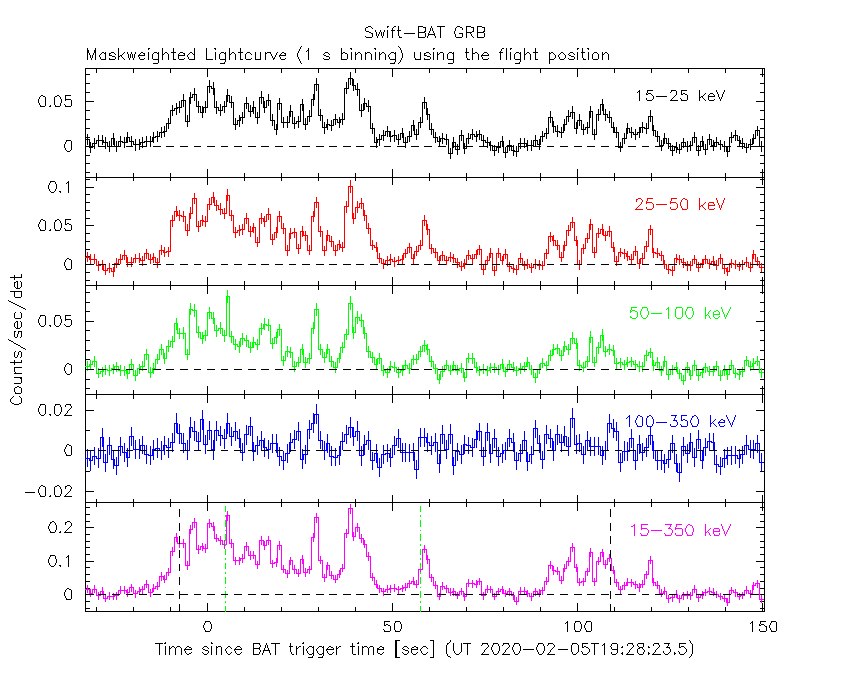
P.A. Evans (U. Leicester), J.P. Osborne (U. Leicester) and K.K. Simpson (PSU) for the Swift team
At 19:21:43 UT, the Swift Burst Alert Telescope (BAT) triggered and located GRB 200205B (trigger=954519 and 954520) (Evans et al. GCN Circ. 26993). Swift slewed to the burst after a short delay. At the time of the trigger, the initial BAT position was 103° from the Sun (9.9 hours East) and 81° from the 85%-illuminated Moon. Table 1 contains the best reported positions from Swift, and the latest XRT position can be viewed at http://www.swift.ac.uk/xrt_positions.
Evans et al. (GCN Circ. 26993) reported the discovery with UVOT of an optical afterglow. Vielfaure et al. (GCN Circ. 26998) determined a redshift of 1.465 from VLT. Table 2 is a summary of GCN Circulars about this GRB from observatories other than Swift.
Standard analysis products for this burst are available at https://gcn.gsfc.nasa.gov/swift_gnd_ana.html.
Analysis of the BAT data was reported by Ukwatta et al. (GCN Circ. 27012). We have combined the data from two triggers (#954519 and #954520) for the analysis. All the times in this circular are relative to the trigger time from #954519.
The mask-weighted light curve (Figure 1) shows several pulses that start from ~T+20 s and end at ~T+550 s.
The first prominent pulse occurs at ~T+60 s, followed by another significant structure with several overlapping pulses from ~T+380 s to ~T+520 s.
There is a data gap from T+63 s to T+160 s, likely due to problems of saving data because of the double triggers.
The results of the batgrbproduct analysis are available at https://gcn.gsfc.nasa.gov/notices_s/954520/BA/.
Analysis of the initial XRT data was reported by Osborne et al. (GCN Circ. 27001). We have analysed 6.5 ks of XRT data for GRB 200205B, from 332 s to 46.4 ks after the BAT trigger. The data comprise 360 s in Windowed Timing (WT) mode (the first 8 s were taken while Swift was slewing) with the remainder in Photon Counting (PC) mode.
The late-time light curve (Figure 2) (from T0+5.3 ks) can be modelled with a power-law decay with a decay index of α=0.76 (+0.14, -0.13).
A spectrum formed from the WT mode data can be fitted with an absorbed
power-law with a photon spectral index of 1.129 (+0.027, -0.026). The
best-fitting absorption column is 4.9 (+1.2, -1.1) x 1
The Swift/UVOT began settled observations of the field of GRB 200205B 352 s after the BAT trigger
(Simpson and Evans GCN Circ. 27006).
A source consistent with the XRT position is detected in the initial UVOT exposures.
Table 3 gives preliminary
magnitudes using the UVOT photometric system
(Breeveld et al. 2011, AIP Conf. Proc., 1358, 373).
No correction has been made for the expected extinction in the Milky Way
corresponding to a reddening of

Figure 1. The BAT
mask-weighted light curve in the four individual and total
energy bands. The units are counts
| RA (J2000) | Dec (J2000) | Error | Note | Reference |
|---|---|---|---|---|
| 0 |
-56°29'15.3" | 0.42" | UVOT-refined | Simpson and Evans GCN Circ. 27006 |
| 0 |
-56°29'14.7" | 1.6" | XRT-enhanced | Beardmore et al. GCN Circ. 26999 |
| 0 |
-56°29'18.1" | 1.8' | BAT-refined | Ukwatta et al. GCN Circ. 27012 |
| Band | Authors | GCN Circ. | Subject | Observatory | Notes |
|---|---|---|---|---|---|
| Optical | Strausbaugh and Cucchiara | 26995 | LCO Optical Detection | LCO | detection |
| Optical | Vielfaure et al. | 26998 | VLT/X-shooter redshift | VLT | redshift |
| Optical | Malesani et al. | 27004 | ESO/NTT near-infrared imaging | detection | |
| Optical | Mazaeva et al. | 27027 | Chilescope optical observations | marginal detection | |
| Gamma-ray | Tsvetkova et al. | 27034 | Konus-Wind observation | Konus-Wind | Fluence=1.12(-0.05,+0.26)x1 |
| Filter | Exp(s) | Mag | ||
|---|---|---|---|---|
| white | 6386 | 6586 | 196 | 18.92± 0.10 |
| white | 383 | 1042 | 478 | 16.81± 0.03 |
| v | 540 | 733 | 38 | 16.88 ± |
| b | 638 | 833 | 38 | 17.74 ± |
| u | 614 | 808 | 38 | 17.25 ± |
| w1 | 589 | 783 | 38 | 16.88± 0.20 |
| m2 | 564 | 758 | 38 | 17.12 ± 0.28 |
| w2 | 689 | 1056 | 46 | >17.77 |
Table 3. UVOT observations reported by Simpson and Evans (GCN Circ. 27006). The start and stop times of the exposures are given in seconds since the BAT trigger. The preliminary detections and 3-σ upper limits are given. No correction has been made for extinction in the Milky Way.
February 12, 2020